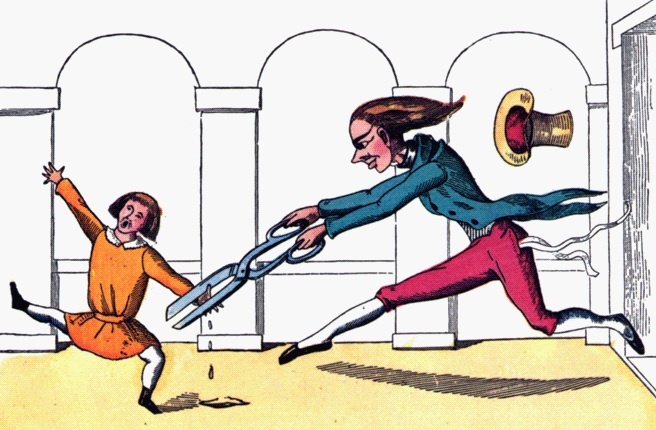Der Struwwelpeter (Slovenly Peter)

Annotation
Published in 1858, Der Struwwelpeter (Shaggy Peter) is a German children's book first published anonymously under a different title in 1845 by Heinrich Hoffman. Hoffman, a Frankfurt physician and father, wrote the book after realizing that there were none he wanted to buy for his 3-year-old son for Christmas. The first English translation was published in 1848. While living in Berlin with his family in 1891, Mark Twain translated the book he gave to his three daughters for Christmas. According to one, her father had been motivated by his close identification with the children in Der Struwwelpter. Twain's American version, Slovenly Peter, was published in 1935.[1]
The 10 cautionary tales told in rhyme are accompanied by vivid illustrations of boys and girls in nightmarish scenarios. The cartoon-like illustrations depict the dire consequences of such disobedient and unwise behavior as: poor hygiene, cruelty, playing with matches, bullying, thumb sucking, eating poorly, fidgeting at the table, and not paying attention while walking. While many German parents today find the tales disturbing, those who raised their children during the early decades of the 20th century found them useful for childrearing. Parents' mention of a specific character in Der Struwwelpeter kids knew well served as short-hand criticism of objectionable behavior.
What happens to disobedient children who suck their thumbs when told not to is illustrated in four panels. In the third one, Conrad's thumbs are about to be cut off by the tailor because he did not listen to his mother warning him not to suck his thumbs while she went out.
Students might analyze the text as well as the images in regard to issues of gender and race. (For bullying a boy of color the bullies are dipped in black ink.) The book could also be compared to other proscriptive stories from different periods, nationalities, and cultures. Another rich avenue for research would be to examine children's varied reactions to Der Stuvwwelpeter.
A version of the American translation, Struwwelpeter: Merry Tales and Funny Pictures, is available on The Project Gutenberg EBook.
[1] For a useful scholarly essay see: J. D. (John Daniel) Stahl, Mark Twain's "Slovenly Peter" in the Context of Twain and German Culture. The Lion and the Unicorn, Vol. 20, No 2, December 1996, pp. 166-180.
Transcription
Die Geschichte vom Daumenlutscher
"Konrad," sprach die Frau Mama,
"ich geh aus und du bleibst da.
Sei hübsch ordentlich und fromm,
bis nach Haus ich wieder komm.
Und vor allem, Konrad, hör!
lutsche nicht am Daumen mehr;
denn der Schneider mit der Scher
kommt sonst ganz geschwind daher,
und die Daumen schneidet er
ab, als ob Papier es wär."
Fort geht nun die Mutter und
wupp! den Daumen in den Mund.
Bauz! da geht die Türe auf,
und herein in schnellem Lauf
springt der Schneider in die Stub
zu dem Daumen-Lutscher-Bub.
Weh! jetzt geht es klipp und klapp
mit der Scher die Daumen ab,
mit der großen, scharfen Scher!
Hei! da schreit der Konrad sehr.
Als die Mutter kommt nach Haus,
sieht der Konrad traurig aus.
Ohne Daumen steht er dort,
die sind alle beide fort.
Translation
Story of the Thumb-Sucker
"Konrad!" cried his mamma dear,
"I'll go out, but you stay here,
Try how pretty you can be
Till I come again," said she.
"Docile be, and good and mild,
Pray don't suck your thumb, my child,
For if you do, the tailor'll come
And bring his shears and snip your thumb
From off your hand as clear and clean
As if paper it had been."
Before she'd turned the south,
He'd got his thumbkin in his mouth!
Bang! here goes the door ker-slam!
Whoop! the tailor lands ker-blam!
Waves his shears, the heartless grub,
and calls for Dawmen-lutscher-bub.
Claps his weapon to the thumb,
Snips it square as head of grum,
While that lad his tongue unfurled
And fired a yell heard 'round the world.
Who can tell mother's sorrow
When she saw her boy the morrow!
There he stood all steeped in shame,
And not a thumbkin to his name.
Credits
Image available on Wikimedia Commons, S.v. "Struwwelpeter," http://commons.wikimedia.org/wiki/File:Struwwelpeter.png (accessed October 15, 2009). German version: Heinrich Hoffmann, Der Struwwelpeter: oder lustige Geschichten und drollige Bilder (Rütten & Loening Verlag in Frankfurt am Main, 1871), Project Gutenberg, http://www.gutenberg.org/files/24571/24571-8.txt (accessed October 23, 2009). American Version: Heinrich Hoffmann, Der Struwwelpeter: Merry Stories and Funny Pictures, (New York: Frederic Warne & Co. [n.d.]), Project Gutenberg, http://www.gutenberg.org/etext/12116 (accessed October 23, 2009). Annotated by Miriam Forman-Brunell.